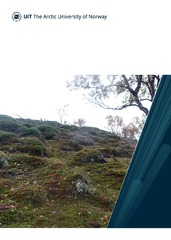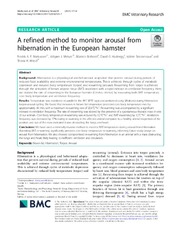Institutt for arktisk og marin biologi: Nye registreringer
Viser treff 901-920 av 2086
-
Vegetation-environment analysis of areas with peat accumulation and hummock formation in the context of NiN (Natur i Norge). A study from Laggu, Gamvik municipality, Troms and Finnmark county.
(Master thesis; Mastergradsoppgave, 2021-05-18)A conspicuous type of heath and forest with peat accumulation and hummock formation in terrestrial systems has been investigated in Laggu, Gamvik municipality in northern Norway. The aim was to describe vegetational composition, soil depth and hummock distribution, and identify environmental factors that cause terrestrial peat accumulation. Vascular plants, bryophytes and lichens were registered ... -
Changes in fat metabolism in the seasonal body mass cycle of captive Svalbard rock ptarmigan (Lagopus muta hyperborea)
(Master thesis; Mastergradsoppgave, 2021-05-12)The Svalbard ptarmigan exhibits profound seasonal variations in body mass. The deposition of fat in the fall is an adaptation that allows the ptarmigan to survive periods of food shortages during the Arctic winter. In this study, previously unexplored molecular aspects of this well- established body mass cycle were investigated. Captive Svalbard ptarmigan fed ad libitum and kept under short photoperiod ... -
A refined method to monitor arousal from hibernation in the European hamster
(Journal article; Tidsskriftartikkel; Peer reviewed, 2021-01-07)<i>Background</i> - Hibernation is a physiological and behavioural adaptation that permits survival during periods of reduced food availability and extreme environmental temperatures. This is achieved through cycles of metabolic depression and reduced body temperature (torpor) and rewarming (arousal). Rewarming from torpor is achieved through the activation of brown adipose tissue (BAT) associated ... -
Meroplankton Diversity, Seasonality and Life-History Traits Across the Barents Sea Polar Front Revealed by High-Throughput DNA Barcoding
(Journal article; Tidsskriftartikkel; Peer reviewed, 2021-05-28)In many species of marine benthic invertebrates, a planktonic larval phase plays a critical role in dispersal. Very little is known about the larval biology of most species, however, in part because species identification has historically been hindered by the microscopic size and morphological similarity among related taxa. This study aimed to determine the taxonomic composition and seasonal ... -
Immunologic Profiling of the Atlantic Salmon Gill by Single Nuclei Transcriptomics
(Journal article; Tidsskriftartikkel; Peer reviewed, 2021-05-04)Anadromous salmonids begin life adapted to the freshwater environments of their natal streams before a developmental transition, known as smoltification, transforms them into marine-adapted fish. In the wild, smoltification is a photoperiod-regulated process, involving radical remodeling of gill function to cope with the profound osmotic and immunological challenges of seawater (SW) migration. While ... -
Keeping close to the river, shore and surface: the first marine migration of brown trout (Salmo trutta) and Arctic charr (Salvelinus alpinus) post-smolts
(Journal article; Tidsskriftartikkel; Peer reviewed, 2021-03-23)Acoustic telemetry was utilized to track 49 brown trout (<i>Salmo trutta</i>) and 37 Arctic charr (<i>Salvelinus alpinus</i>) first-time migrants of wild origin [post-smolts; mean LF (fork length): 169 and 172 mm] in a large fjord in northern Norway. The <i>S. trutta</i> were registered at sea for more than twice the time of the <i>S. alpinus</i> (medians of 54 and 22 days, respectively). Both species ... -
Screening of Eurasian Tundra Reindeer for Viral Sequences by Next-Generation Sequencing
(Journal article; Tidsskriftartikkel; Peer reviewed, 2021-06-18)Reindeer husbandry is essential for the livelihood and culture of indigenous people in the Arctic. Parts of the herding areas are also used as pastures for farm animals, facilitating potential transmission of viruses between species. Following the Covid-19 pandemic, viruses circulating in the wild are receiving increased attention, since they might pose a potential threat to human health. Climate ... -
Within and between breeding-season changes in contaminant occurrence and body condition in the Antarctic breeding south polar skua
(Journal article; Tidsskriftartikkel; Peer reviewed, 2021-05-24)The Antarctic ecosystem represents a remote region far from point sources of pollution. Still, Antarctic marine predators, such as seabirds, are exposed to organohalogen contaminants (OHCs) which may induce adverse health effects. With increasing restrictions and regulations on OHCs, the levels and exposure are expected to decrease over time. We studied south polar skua (<i>Catharacta maccormicki</i>), ... -
Centennial relationships between ocean temperature and Atlantic puffin production reveal shifting decennial trends
(Journal article; Tidsskriftartikkel; Peer reviewed, 2021-05-24)The current warming of the oceans has been shown to have detrimental effects for a number of species. An understanding of the underlying mechanisms may be hampered by the non-linearity and non-stationarity of the relationships between temperature and demography, and by the insufficient length of available time series. Most demographic time series are too short to study the effects of climate on ... -
Shallow-Water Scavengers of Polar Night and Day – An Arctic Time-Lapse Photography Study
(Journal article; Tidsskriftartikkel; Peer reviewed, 2021-05-24)Until recently, polar night constituted truly a “mare incognitum” of our times. Yet, the first records from this very little-explored period showcased a surprisingly rich and active ecosystem. This investigation aims to reveal the level of scavenger activity during both Arctic polar night and day. It compares the shallow-water scavenging fauna observed during two contrasting seasons (winter vs. ... -
A marine zooplankton community vertically structured by light across diel to interannual timescales
(Journal article; Tidsskriftartikkel; Peer reviewed, 2021-02-24)The predation risk of many aquatic taxa is dominated by visually searching predators, commonly a function of ambient light. Several studies propose that changes in visual predation will become a major climate-change impact on polar marine ecosystems. The High Arctic experiences extreme seasonality in the light environment, from 24 h light to 24 h darkness, and therefore provides a natural laboratory ... -
The occurrence of Nematoda in coastal sea ice on Svalbard (European Arctic) determined with the 18S small subunit rRNA gene
(Journal article; Tidsskriftartikkel; Peer reviewed, 2021-05-06)Understanding the diversity and functioning of Arctic sea ice ecosystems is vital to evaluate and predict the impact of current and future climate change. In the microscopic communities inhabiting the brine channels inside sea ice, nematodes often dominate numerically and act as bacterivores and herbivores. Despite nematodes great abundances and known ecological roles, molecular tools have not been ... -
Bearded seal (Erignathus barbatus) vocalizations across seasons and habitat types in Svalbard, Norway
(Journal article; Tidsskriftartikkel; Peer reviewed, 2021-05-17)Male bearded seals (Erignathus barbatus) use vocal displays to attract females and to compete with other males during the mating season. This makes it possible to monitor breeding populations of this species using passive acoustic monitoring (PAM). This study analysed year-round acoustic data records from AURAL instruments in Svalbard (Norway) to investigate seasonal variation in the acoustic presence ... -
SIOS’s Earth Observation (EO), Remote Sensing (RS), and operational activities in response to COVID-19
(Journal article; Tidsskriftartikkel; Peer reviewed, 2021-02-15)Svalbard Integrated Arctic Earth Observing System (SIOS) is an international partnership of research institutions studying the environment and climate in and around Svalbard. SIOS is developing an efficient observing system, where researchers share technology, experience, and data, work together to close knowledge gaps, and decrease the environmental footprint of science. SIOS maintains and facilitates ... -
Iterative model predictions for wildlife populations impacted by rapid climate change
(Journal article; Tidsskriftartikkel; Peer reviewed, 2021-01-14)To improve understanding and management of the consequences of current rapid environmental change, ecologists advocate using long-term monitoring data series to generate iterative near-term predictions of ecosystem responses. This approach allows scientific evidence to increase rapidly and management strategies to be tailored simultaneously. Iterative near-term forecasting may therefore be particularly ... -
Modeling silicate–nitrate–ammonium co-limitation of algal growth and the importance of bacterial remineralization based on an experimental Arctic coastal spring bloom culture study
(Journal article; Tidsskriftartikkel; Peer reviewed, 2021-03-11)Arctic coastal ecosystems are rapidly changing due to climate warming. This makes modeling their productivity crucially important to better understand future changes. System primary production in these systems is highest during the pronounced spring bloom, typically dominated by diatoms. Eventually the spring blooms terminate due to silicon or nitrogen limitation. Bacteria can play an important role ... -
Terrestrial Inputs Shape Coastal Bacterial and Archaeal Communities in a High Arctic Fjord (Isfjorden, Svalbard)
(Journal article; Tidsskriftartikkel; Peer reviewed, 2021-02-26)The Arctic is experiencing dramatic changes including increases in precipitation, glacial melt, and permafrost thaw, resulting in increasing freshwater runoff to coastal waters. During the melt season, terrestrial runoff delivers carbon- and nutrient-rich freshwater to Arctic coastal waters, with unknown consequences for the microbial communities that play a key role in determining the cycling and ... -
Analysis across diverse fish species highlights no conserved transcriptome signature for proactive behaviour
(Journal article; Tidsskriftartikkel; Peer reviewed, 2021-01-07)<p>Background: Consistent individual differences in behaviour, known as animal personalities, have been demonstrated within and across species. In fish, studies applying an animal personality approach have been used to resolve variation in physiological and molecular data suggesting a linkage, genotype-phenotype, between behaviour and transcriptome regulation. In this study, using three fish species ... -
Influence of Arctic light conditions on crop production and quality
(Journal article; Tidsskriftartikkel; Peer reviewed, 2021-04-10)The natural light conditions above the Arctic Circle are unique in terms of annual variation creating special growth conditions for crop production. These include low solar elevations, very long daily photosynthetic light periods, midnight sun/absence of dark nights, and altered spectral distribution depending on solar elevation. All these factors are known to affect the growth and the metabolism ... -
Widely rhythmic transcriptome in Calanus finmarchicus during the high Arctic summer solstice period
(Journal article; Tidsskriftartikkel; Peer reviewed, 2020-12-10)Solar light/dark cycles and seasonal photoperiods underpin daily and annual rhythms of life on Earth. Yet, the Arctic is characterized by several months of permanent illumination (“midnight sun”). To determine the persistence of 24h rhythms during the midnight sun, we investigated transcriptomic dynamics in the copepod <i>Calanus finmarchicus</i> during the summer solstice period in the Arctic, with ...


 English
English norsk
norsk


















